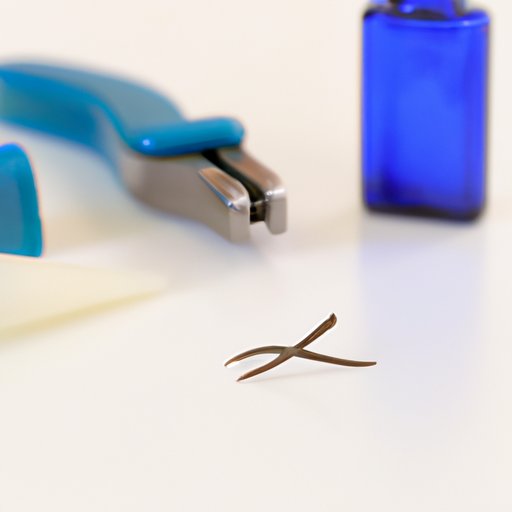Introduction
Tick removal should be taken seriously as ticks can transmit serious diseases. According to the Centers for Disease Control and Prevention (CDC), tick-borne diseases are on the rise, making prevention and safe removal more important than ever before. This article will provide you with the safest and most effective ways to remove a tick from your skin and protect yourself from tick-borne diseases.
“The Safest and Most Effective Ways to Remove a Tick from Your Skin”
Safe and effective tick removal is important to prevent diseases such as Lyme disease, Rocky Mountain spotted fever, and anaplasmosis. There are common misconceptions about tick removal, such as using petroleum jelly or burning the tick off your skin, that can actually increase the risk of infection. The safest and most effective methods for tick removal are using a fine-tipped tweezers or a tick removal tool.
“Step-by-Step Guide to Removing Ticks: Don’t Panic, Here’s What To Do”
If you find a tick on your skin, it is important not to panic. Follow these steps to remove the tick safely and effectively:
- Use fine-tipped tweezers or a tick removal tool.
- Grip the tick’s head as close to the skin as you can.
- Pull upward with steady, even pressure.
- Do not twist or jerk the tick, as this can cause the mouthparts to break off and stay in the skin.
- After removing the tick, clean the bite area and your hands with rubbing alcohol or soap and water.
It’s important to avoid squeezing the tick’s body during removal, which can force bacteria into your bloodstream and increase the risk of infection.
“The Do’s and Don’ts of Tick Removal: Protect Yourself from Tick-Borne Diseases”
Protecting yourself from tick-borne diseases starts with proper tick removal. The dos and don’ts of tick removal include:
- Do use fine-tipped tweezers or a tick removal tool.
- Do grasp the tick’s head as close to the skin as possible.
- Do pull upward with steady, even pressure.
- Don’t use petroleum jelly, nail polish, or a hot match to remove the tick.
- Don’t twist or jerk the tick.
Properly disposing of the tick after removal is also important. You can dispose of the tick by flushing it down the toilet, placing it in alcohol, or sealing it in a bag and throwing it away.
“Tools and Techniques: The Best Way to Remove a Tick and Prevent Infection”
There are many different tools and techniques for removing ticks, including tick removal tweezers, tick key, and tick twister.
The best tool for tick removal depends on the situation. Fine-tipped tweezers are a great all-around option, but if you’re in an area with a lot of ticks, you may want to consider a tick removal kit that includes multiple tools.
Preventing infection after tick removal is also important. Apply an antiseptic to the bite area and wash your hands with soap and water.
“Natural Remedies for Tick Removal: Simple Tips That Really Work”
There are a variety of natural remedies for tick removal, including using essential oils, apple cider vinegar, and garlic.
While these remedies may have some effectiveness, it’s important to keep in mind that they have not been scientifically proven to be as effective as using tweezers or a tick removal tool. Additionally, some natural remedies may cause skin irritation or allergic reactions, so it’s essential to do a patch test before using them.
“Expert Advice: How to Remove a Tick Safely and Prevent Health Complications”
According to experts, the best way to remove a tick is to use fine-tipped tweezers or a tick removal tool. It’s essential to avoid squeezing the tick’s body or twisting it, which can increase the risk of infection and can cause the tick’s mouthparts to break off and stay in the skin.
If you experience symptoms such as fever, rash, or joint pain after being bitten by a tick, it’s important to seek medical attention promptly, as these could be signs of a tick-borne disease.
Conclusion
Proper tick removal is essential to prevent tick-borne diseases. The safest and most effective way to remove a tick is to use fine-tipped tweezers or a tick removal tool. It’s important not to twist or jerk the tick and to dispose of it properly after removal. Protect yourself from tick-borne diseases by following proper tick removal techniques and seeking medical attention if necessary.
